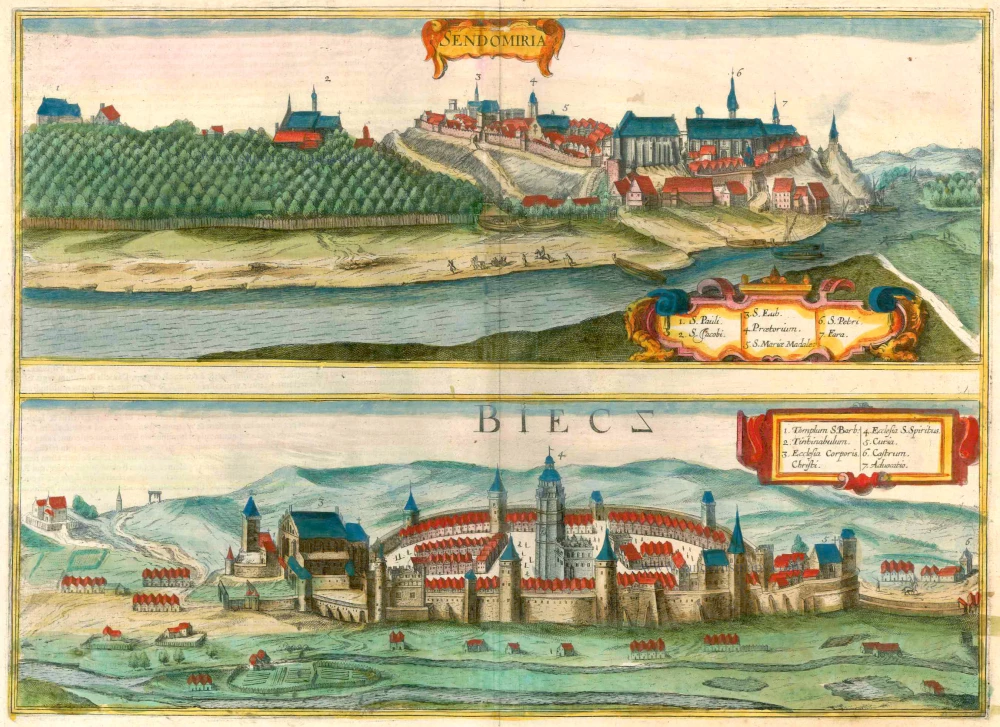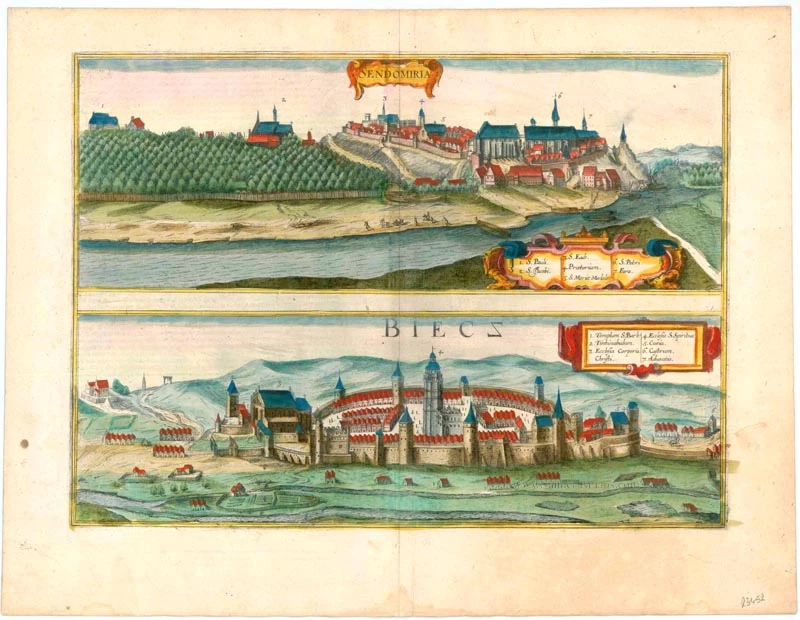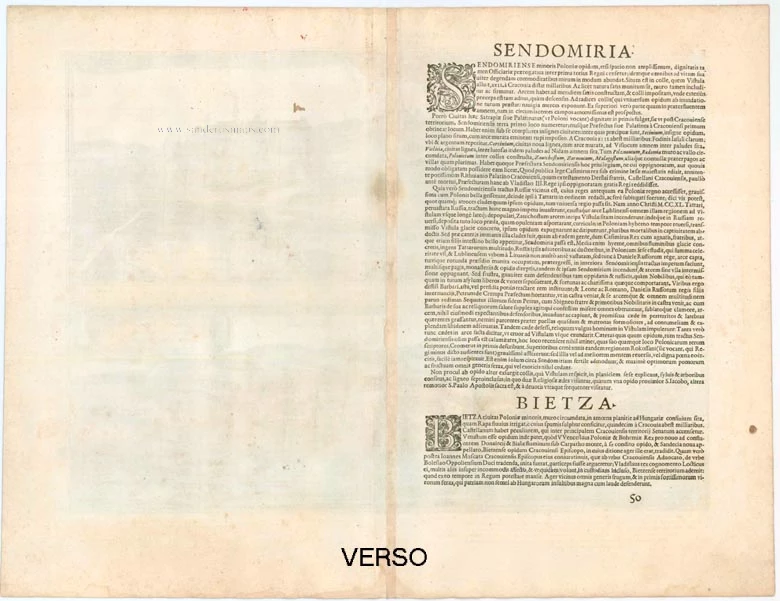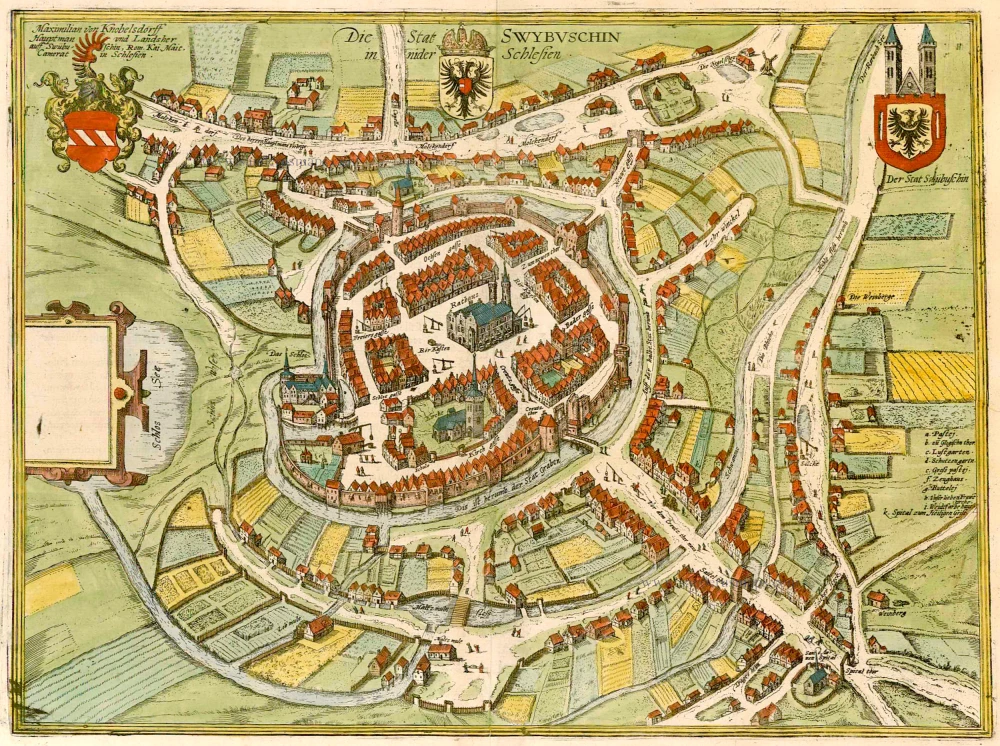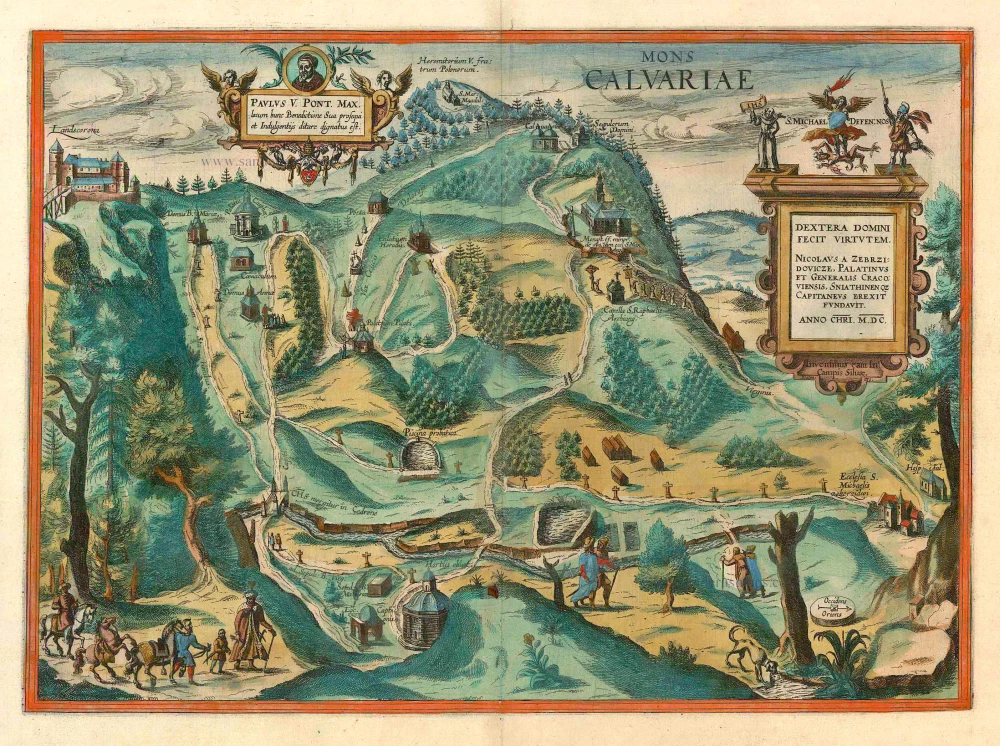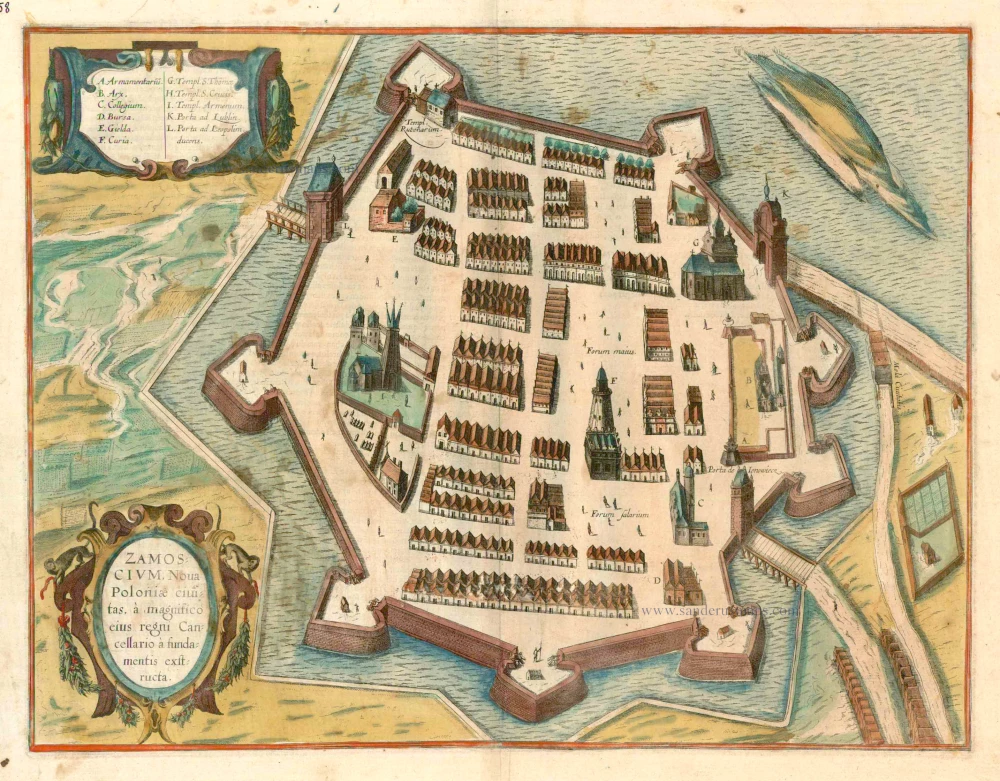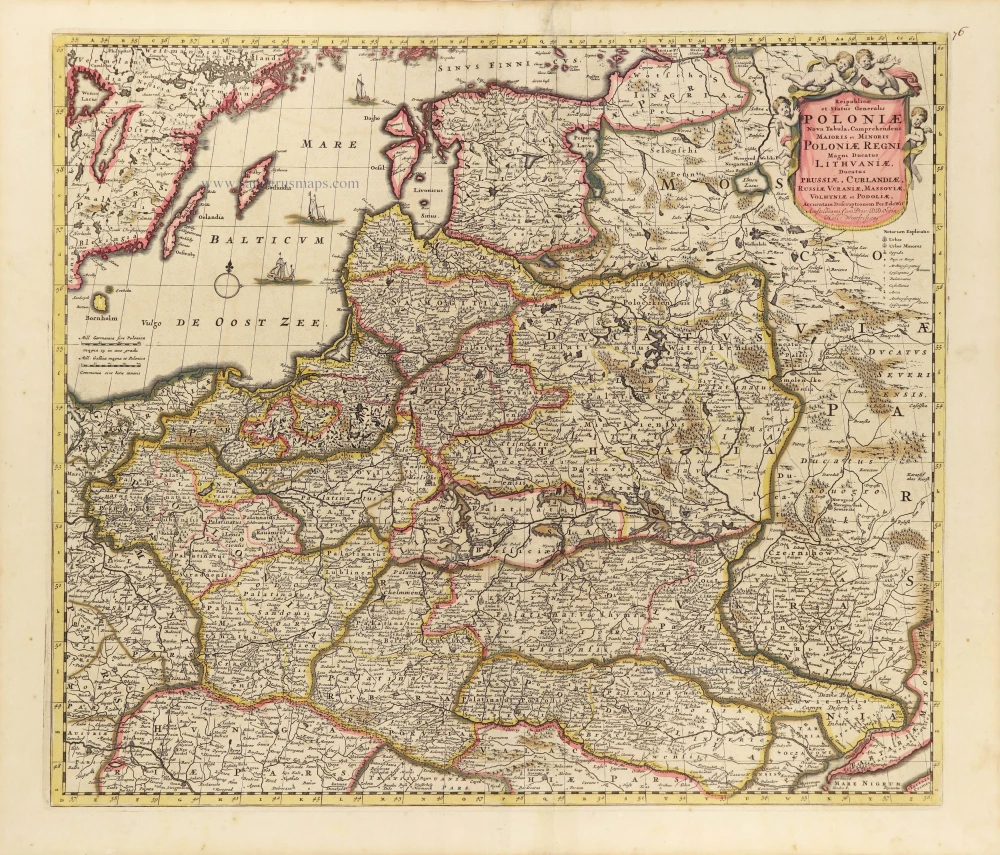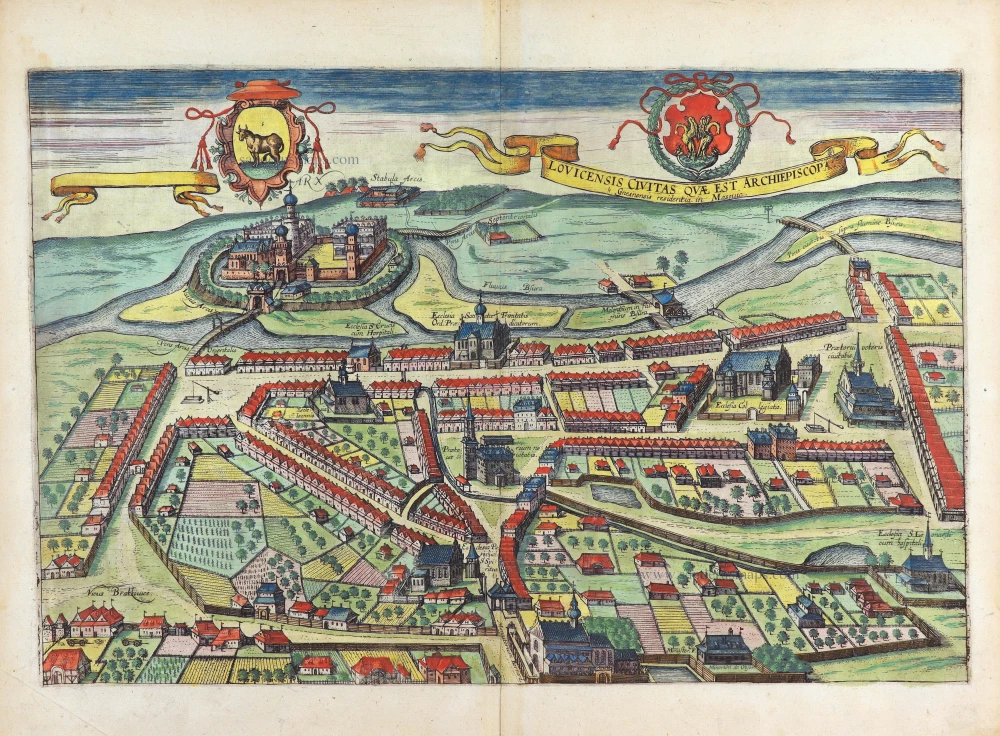Sandomierz and Biecz in Poland, by Georg Braun and Frans Hogenberg. 1618
SANDOMIERZ COMMENTARY BY BRAUN (on verso): "Although it lies in Lesser Poland and is not very big, the town of Sandomierz is considered to be one of the finest because of its splendid place. [...] It lies 22 miles from Cracow on a hill beside the Vistula. Despite its favorable position the town is fortified with a strong wall. It is crowned by a stone castle." This neat view shows the town on a hill at a crossing point over the River Vistula. It was named after the River San, which flows here into the Vistula. The towering cathedral of the Nativity of the Blessed Virgin Mary dominates the plate and the palace can be identified at the centre. Sandomierz was founded in 1236 by the Piast rulers, destroyed in the 12th century by the Tartars, then rebuilt by Casimir I. In the 14th century it was surrounded by mighty fortifications. As sedes regni principales it was the seat of the princes and a royal residence. The trade routes that passed here brought prosperity to the town. It flourished in the 15th/16th centuries as a centre of cloth weaving. The Old Town is one of the best preserved in Poland. BIECZ COMMENTARY BY BRAUN (on verso): "This little town is also in Lesser Poland, 15 miles from Cracow towards the Hungarian border, on the River Ropa, which has the strange but wonderful property that sulphur can be made out of its foam. It has its own castellan or warden who sits in the regional council of Cracow." This is a view from the south of Biecz on the River Ropa, west of Krosno in southeast Poland. The detailed drawing of the fortifications constrasts markedly with the schematic representation and arrangement of the town houses, which in no way suggests that the town was sometimes referred to as "Little Cracow". The marketplace is dominated by the town hall dating from the 15th/16th centuries, with its mighty tower. The church of Corpus Christi (3) which is considered to be one of the finest late Gothic churches in Lesser Poland, can be identified on the left. Biecz was granted a municipal charter in 1303; it developed rapidly due to its favourable position on trade routes and became a centre of long-distance trade with Hungary. (Taschen)
Braun G. & Hogenberg F. and the Civitates Orbis Terrarum.
The Civitates Orbis Terrarum, or the "Braun & Hogenberg", is a six-volume town atlas and the most excellent book of town views and plans ever published: 363 engravings, sometimes beautifully coloured. It was one of the best-selling works in the last quarter of the 16th century. Georg Braun wrote the text accompanying the plans and views on the verso. Many plates were engraved after the original drawings of a professional artist, a professional artist, Joris Hoefnagel (1542-1600). The first volume was published in Latin in 1572, and the sixth in 1617. Frans Hogenberg created the tables for volumes I through IV, and Simon van den Neuwel made those for volumes V and VI. Other contributors were cartographers Daniel Freese and Heinrich Rantzau. Works by Jacob van Deventer, Sebastian Münster, and Johannes Stumpf were also used. Translations appeared in German and French.
Following the original publication of Volume 1 of the Civitates in 1572, seven further editions of 1575, 1577, 1582, 1588, 1593, 1599 and 1612 can be identified. Vol.2, first issued in 1575, was followed by further editions in 1597 and 1612. The subsequent volumes appeared in 1581, 1588, 1593, 1599 and 1606. The German translation of the first volume appeared from 1574 on, and the French edition from 1575 on.
Several printers were involved: Theodor Graminaeus, Heinrich von Aich, Gottfried von Kempen, Johannis Sinniger, Bertram Buchholtz and Peter von Brachel, who all worked in Cologne.
Georg Braun (1541-1622)
Georg Braun was born in Cologne in 1541. After his studies in Cologne, he entered the Jesuit Order as a novice. 1561, he obtained his bachelor's degree, and in 1562, he received his Magister Artium. Although he left the Jesuit Order, he studied theology, gaining a licentiate in theology.
Frans Hogenberg (1535-1590)
Frans Hogenberg was a Flemish and German painter, engraver, and mapmaker. He was born in Mechelen as the son of Nicolaas Hogenberg.
By the end of the 1560s, Frans Hogenberg was employed upon Abraham Ortelius's Theatrum Orbis Terrarum, published in 1570; he is named an engraver of numerous maps. In 1568, he was banned from Antwerp by the Duke of Alva and travelled to London, where he stayed a few years before emigrating to Cologne. He immediately embarked on his two most important works, the Civitates, published in 1572 and the Geschichtsblätter, which appeared in several series from 1569 until about 1587.
Thanks to large-scale projects like the Geschichtsblätter and the Civitates, Hogenberg's social circumstances improved with each passing year. He died as a wealthy man in Cologne in 1590.
Sendomiria [on sheet with] Biecz
Item Number: 23452 Authenticity Guarantee
Category: Antique maps > Europe > Eastern Europe
Old, antique map with 2 bird's-eye views of Sandomierz and Biecz in Poland, by Georg Braun and Frans Hogenberg.
Date: 1618
First edition: 1617
Copper engraving
Size: 32.5 x 45cm (12.7 x 17.5 inches)
Verso text: Latin
Condition: Excellent, superb old colour.
Condition Rating: A+
References: Van der Krogt 4, 3843; Taschen, Br. Hog., p.479; Fauser, #12427 & #1476; Niewodniczanski, K103/4
From: Theatri praecipuarum Totius Mundi Urbium Liber Sextus Anno MDCXVIII. (Van der Krogt 4, 41:1.6)
SANDOMIERZ COMMENTARY BY BRAUN (on verso): "Although it lies in Lesser Poland and is not very big, the town of Sandomierz is considered to be one of the finest because of its splendid place. [...] It lies 22 miles from Cracow on a hill beside the Vistula. Despite its favorable position the town is fortified with a strong wall. It is crowned by a stone castle." This neat view shows the town on a hill at a crossing point over the River Vistula. It was named after the River San, which flows here into the Vistula. The towering cathedral of the Nativity of the Blessed Virgin Mary dominates the plate and the palace can be identified at the centre. Sandomierz was founded in 1236 by the Piast rulers, destroyed in the 12th century by the Tartars, then rebuilt by Casimir I. In the 14th century it was surrounded by mighty fortifications. As sedes regni principales it was the seat of the princes and a royal residence. The trade routes that passed here brought prosperity to the town. It flourished in the 15th/16th centuries as a centre of cloth weaving. The Old Town is one of the best preserved in Poland. BIECZ COMMENTARY BY BRAUN (on verso): "This little town is also in Lesser Poland, 15 miles from Cracow towards the Hungarian border, on the River Ropa, which has the strange but wonderful property that sulphur can be made out of its foam. It has its own castellan or warden who sits in the regional council of Cracow." This is a view from the south of Biecz on the River Ropa, west of Krosno in southeast Poland. The detailed drawing of the fortifications constrasts markedly with the schematic representation and arrangement of the town houses, which in no way suggests that the town was sometimes referred to as "Little Cracow". The marketplace is dominated by the town hall dating from the 15th/16th centuries, with its mighty tower. The church of Corpus Christi (3) which is considered to be one of the finest late Gothic churches in Lesser Poland, can be identified on the left. Biecz was granted a municipal charter in 1303; it developed rapidly due to its favourable position on trade routes and became a centre of long-distance trade with Hungary. (Taschen)
Braun G. & Hogenberg F. and the Civitates Orbis Terrarum.
The Civitates Orbis Terrarum, or the "Braun & Hogenberg", is a six-volume town atlas and the most excellent book of town views and plans ever published: 363 engravings, sometimes beautifully coloured. It was one of the best-selling works in the last quarter of the 16th century. Georg Braun wrote the text accompanying the plans and views on the verso. Many plates were engraved after the original drawings of a professional artist, a professional artist, Joris Hoefnagel (1542-1600). The first volume was published in Latin in 1572, and the sixth in 1617. Frans Hogenberg created the tables for volumes I through IV, and Simon van den Neuwel made those for volumes V and VI. Other contributors were cartographers Daniel Freese and Heinrich Rantzau. Works by Jacob van Deventer, Sebastian Münster, and Johannes Stumpf were also used. Translations appeared in German and French.
Following the original publication of Volume 1 of the Civitates in 1572, seven further editions of 1575, 1577, 1582, 1588, 1593, 1599 and 1612 can be identified. Vol.2, first issued in 1575, was followed by further editions in 1597 and 1612. The subsequent volumes appeared in 1581, 1588, 1593, 1599 and 1606. The German translation of the first volume appeared from 1574 on, and the French edition from 1575 on.
Several printers were involved: Theodor Graminaeus, Heinrich von Aich, Gottfried von Kempen, Johannis Sinniger, Bertram Buchholtz and Peter von Brachel, who all worked in Cologne.
Georg Braun (1541-1622)
Georg Braun was born in Cologne in 1541. After his studies in Cologne, he entered the Jesuit Order as a novice. 1561, he obtained his bachelor's degree, and in 1562, he received his Magister Artium. Although he left the Jesuit Order, he studied theology, gaining a licentiate in theology.
Frans Hogenberg (1535-1590)
Frans Hogenberg was a Flemish and German painter, engraver, and mapmaker. He was born in Mechelen as the son of Nicolaas Hogenberg.
By the end of the 1560s, Frans Hogenberg was employed upon Abraham Ortelius's Theatrum Orbis Terrarum, published in 1570; he is named an engraver of numerous maps. In 1568, he was banned from Antwerp by the Duke of Alva and travelled to London, where he stayed a few years before emigrating to Cologne. He immediately embarked on his two most important works, the Civitates, published in 1572 and the Geschichtsblätter, which appeared in several series from 1569 until about 1587.
Thanks to large-scale projects like the Geschichtsblätter and the Civitates, Hogenberg's social circumstances improved with each passing year. He died as a wealthy man in Cologne in 1590.

